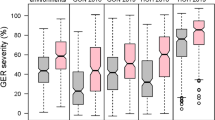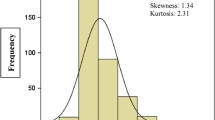Abstract
Gibberella ear rot (GER) of maize caused by Fusarium graminearum reduces grain yield and leads to contamination of the grains with deoxynivalenol (DON), a mycotoxin that adversely affects the health of humans and animals. The objectives of this study were to (1) analyze means and genotypic variances for line per se performance (LP) and testcross performance (TP) of doubled haploid (DH) lines for GER severity and DON concentration as well as for some agronomic traits, (2) examine correlations among these traits, (3) validate QTL for resistance detected in previous studies for LP and their effect on TP and (4) investigate the relative efficiency of indirect selection (RE) for LP to improve TP. Testcross progenies of 94 DH lines originating from four flint populations were developed using a susceptible dent tester as pollinator. Artificial inoculations with F. graminearum led to appreciable disease development. Average TP for GER severity and DON concentration were lower than the mean mid-parent values of the tester and DH lines, indicating mid-parent heterosis for resistance. Genotypic variation for resistance was significant for LP and TP. Genotypic correlations between LP and TP were low and resistance QTL for LP had no significant effects on TP. Accordingly, RE for resistance was low, suggesting to allocate resources mostly to the evaluation of testcrosses. Correlations of resistance to GER and DON contamination with grain yield (measured under non-inoculated conditions) were not significant, indicating that selection for resistance and higher grain yield can be carried out simultaneously.

Similar content being viewed by others
References
Ali ML, Taylor JH, Jie L, Sun G, William M, Kasha KJ, Reid LM, Pauls KP (2005) Molecular mapping of QTLs for resistance to Gibberella ear rot, in corn, caused by Fusarium graminearum. Genome 48:521–533
Bolduan C, Miedaner T, Schipprack W, Dhillon BS, Melchinger AE (2009a) Genetic variation for resistance to ear rots and mycotoxins contamination in early European maize inbred lines. Crop Sci 49:2019–2028
Bolduan C, Montes J, Dhillon BS, Mirdita V, Melchinger AE (2009b) Determination of mycotoxin concentration by ELISA and near-infrared spectroscopy in Fusarium-inoculated maize. Cereal Res Commun 37:521–529
Bolduan C, Miedaner T, Utz HF, Dhillon BS, Melchinger AE (2010) Genetic variation in testcrosses and relationship between line per se and testcross performance for resistance to Gibberella ear rot in maize. Crop Sci 50:1691–1696
Cochran WG, Cox GM (1957) Experimental designs. Wiley, New York
Eller MS, Holland JB, Payne GA (2008a) Breeding for improved resistance to fumonisin contamination in maize. Toxin Rev 27:371–389
Eller MS, Robertson-Hoyt LA, Payne GA, Holland JB (2008b) Grain yield and Fusarium ear rot of maize hybrids developed from lines with varying levels of resistance. Maydica 53:231–237
European Commission (2006) Commission Recommendation (EC) No 576/2006 of 17 August 2006 on the presence of deoxynivalenol, zearalenone, ochratoxin A, T-2 and HT-2 and fumonisins in products intended for animal feeding. Off J Eur Union L229:7–9
European Commission (2007) Commission Regulation (EC) No. 1126/2007 of 28 September 2007 amending Regulation (EC) No. 1881/2006 setting maximum levels for certain contaminants in foodstuffs as regards Fusarium toxins in maize and maize products. Off J Eur Union L255:14–17
Falconer DS, Mackay TFC (1996) Introduction to quantitative genetics. Longman group Limited, Harlow
Hallauer AR, Carena MJ, Miranda Filho JB (2010) Handbook of plant breeding: quantitative genetics in maize breeding. Springer, Heidelberg
Leslie JF, Summerell BA, Bullock S (2006) The Fusarium laboratory manual. Blackwell Publishing, Ames
Löffler M, Kessel B, Ouzunova M, Miedaner T (2011) Covariation between line and testcross performance for reduced mycotoxin concentrations in European maize after silk channel inoculation of two Fusarium species. Theor Appl Genet 122:925–934
Lübberstedt T, Melchinger AE, Schön CC, Utz HF, Klein D (1997) QTL mapping in testcrosses of European flint lines of maize: I. Comparison of different testers for forage yield traits. Crop Sci 37:921–931
Martin M, Miedaner T, Dhillon BS, Ufermann U, Kessel B, Ouzunova M, Schipprack W, Melchinger AE (2011a) Colocalization of QTL for Gibberella ear rot resistance and low mycotoxin contamination in early European maize. Crop Sci 51:1935–1945
Martin M, Miedaner T, Schwegler DD, Kessel B, Ouzunova M, Dhillon BS, Schipprack W, Utz HF, Melchinger AE (2011b) Comparative QTL mapping for Gibberella ear rot resistance and reduced deoxynivalenol contamination across connected maize populations. Crop Sci 52:32–43. doi:10.2135/cropsci2011.04.0214
Méchin V, Argillier O, Hébert Y, Guingo E, Moreau L, Charcosset A, Barrière Y (2001) Genetic analysis and QTL mapping of cell wall digestibility and lignification in silage maize. Crop Sci 41:690–697
Melchinger AE, Gumber RK (1998) Overview of heterosis and heterotic groups in agronomic crops. Concepts and Breeding of Heterosis in Crop Plants 25:29-44
Mode CJ, Robinson HF (1959) Pleiotropism and the genetic variance and covariance. Biometrics 15:518–537
Munkvold GP (2003) Epidemiology of Fusarium diseases and their mycotoxins in maize ears. Eur J Plant Pathol 109:705–713
Pestka JJ (2007) Deoxynivalenol: toxicity, mechanisms and animal health risks. Anim Feed Sci Tech 137:283–298
Presello DA, Botta G, Iglesias J, Eyhérabide GH (2008) Effect of disease severity on yield and grain fumonisin concentration of maize hybrids inoculated with Fusarium verticillioides. Crop Prot 27:572–576
Reid LM, Hamilton RI, Mather DE (1996) Screening maize for resistance to Gibberella ear rot. Agriculture and Agri-Food Canada Technical Bulletin
Robertson-Hoyt LA, Kleinschmidt CE, White DG, Payne GA, Maragos CM, Holland JB (2007) Relationships of resistance to Fusarium ear rot and fumonisin contamination with agronomic performance of maize. Crop Sci 47:1770–1778
Schmidt W (2004) Hybridmaiszüchtung bei der KWS SAAT AG. Bericht über die 54.Tagung der Vereinigung der Pflanzenzüchter und Saatgutkaufleute Österreichs 2003:1–6
Searle SR (1971) Linear models. Wiley, New York
Snedecor GW, Cochran WG (1980) Statistical methods. Iowa State University Press, Ames
Utz HF (2005) PLABSTAT—a computer program for statistical analysis of plant breeding experiments 3A
Vigier B, Reid LM, Dwyer LM, Stewart DW, Sinha RC, Arnason JT, Butler G (2001) Maize resistance to gibberella ear rot: symptoms, deoxynivalenol, and yield. Can J Plant Pathol 23:99–105
Acknowledgments
This research was supported by the German Federal Ministry of Food, Agriculture and Consumer Protection in the framework of the “Programm zur Innovationsförderung” (grant no. 28-1-43.001-07 and 28-1-43.002-07). We acknowledge the technical assistance of Nicole Friedl, Jochen Jesse, Heralt Pöschl and Thomas Schmidt. We are grateful to Prof. Dr. H. F. Utz (Institute of Plant Breeding, Seed Science and Population Genetics, Universität Hohenheim, Stuttgart) for his advice on the statistical analyses.
Author information
Authors and Affiliations
Corresponding author
Electronic supplementary material
Below is the link to the electronic supplementary material.
Rights and permissions
About this article
Cite this article
Martin, M., Schipprack, W., Miedaner, T. et al. Variation and covariation for Gibberella ear rot resistance and agronomic traits in testcrosses of doubled haploid maize lines. Euphytica 185, 441–451 (2012). https://doi.org/10.1007/s10681-012-0623-2
Received:
Accepted:
Published:
Issue Date:
DOI: https://doi.org/10.1007/s10681-012-0623-2




